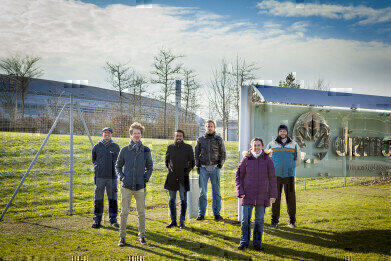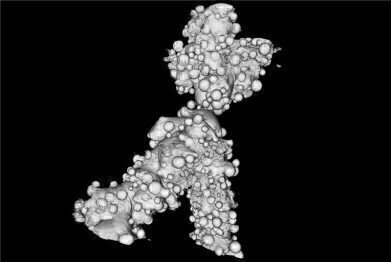-
 David Collins (second from left) from University of Birmingham with the DIAD beamline team (Credit Diamond Light Source)
David Collins (second from left) from University of Birmingham with the DIAD beamline team (Credit Diamond Light Source) -
 3D tomographic image showing a single strut of an un-edged stent. The stent is produced by additive powder manufacturing methods, leaving it with a lumpy surface as seen in the image. The final surface finish will only be achieved after an edging step to remove the rough surface (credit: Diamond Light Source)
3D tomographic image showing a single strut of an un-edged stent. The stent is produced by additive powder manufacturing methods, leaving it with a lumpy surface as seen in the image. The final surface finish will only be achieved after an edging step to remove the rough surface (credit: Diamond Light Source)
News
Milestone reached as Diamond Welcomed First DIAD User
Mar 23 2021
Dr David Collins from the University of Birmingham, became the first user of the Dual Imaging and Diffraction (DIAD) beamline at Diamond Light Source during February, where he worked simultaneously with the DIAD team using the world’s first beamline that can simultaneously perform X-ray imaging and diffraction.
David is studying a biomedical stent that is used to restore blood flow in blocked arteries and DIAD enabled him to study its changes in geometry stent changes under different pressures and link this directly to changes at the sub-crystal scale. This important work will help to produce stents that are perfectly tailored to the different stresses that can be placed on them while sitting for years inside the human body. Ultimately this will mean stents fail less often and treatments will be more reliable.
“What is unique about DIAD is that you have two techniques that can be used simultaneously whereas normally you would have to choose one technique per experiment. Now with DIAD, you can do X-ray Imaging giving you a large-scale image and combine it with X-ray diffraction giving you detail at the sub-crystal scale. Probing two different length scales simultaneously means that you can monitor the very big and the very small at the same time. This opens doors to do many new and exciting experiments that could not have been done before,” explained David.
“A lot of my research is on the cusp of understanding what is happening on a large, component led scale and relating that to what is happening on the sub-crystal length scale. Understanding this link means that there is a chance to engineer something at the atomic scale that can improve processes and materials at a larger scale.”
The first user at DIAD was a landmark occasion representing years of development. DIAD’s Principal Beamline Scientist, Dr Christina Reinhard said: “The DIAD project came from the scientific need to obtain 3D microstructure at the same time as local information about the phase composition and the strain state of the material, ideally at the same time.
“At other beamlines, such as I12, you can do imaging and diffraction experiments, but they can’t be done simultaneously, the end station needs to be modified. That is where DIAD was born, and it was a challenging journey. To perform imaging and diffraction simultaneously we split the X-ray beam in two and each beam goes through its own series optics before they need to be perfectly aligned again at the sample position. This presented a set of technical and logistical challenges, the solutions to which make DIAD truly unique.”
Incorporating two experiments in DIAD required advanced engineering and software, from robot arms moving detectors to automating experiments and analysis, made possible thanks to a huge effort from the engineering, software, optics, planning, facilities and support teams.
Christina added: “I’m so proud of how the whole team came together. Under COVID restrictions, many beamlines were able to operate using small teams. However, building a beamline normally requires a lot of people to work together at the same time. This created novel challenges for the beamline project and it was inspiring to see how the team overcame them. It really would not have been possible without everyone’s hard work and dedication and I would like to thank everyone for that. I’m really looking forward to starting user experiments and get the science up and running. DIAD has applications in many different fields from medicine to battery research.
“The diversity of cutting-edge research that will be done here makes it a very exciting beamline and I can’t wait to open it up to the wider community and eventually welcome users to Diamond in person again.”
DIAD is part-funded by the University of Birmingham through a collaboration that was set up in 2016.
To find out more about the DIAD beamline or discuss potential applications, please contact Principal Beamline Scientist Christina Reinhard: christina.reinhard@diamond.ac.uk
Further information online
Digital Edition
Lab Asia Dec 2025
December 2025
Chromatography Articles- Cutting-edge sample preparation tools help laboratories to stay ahead of the curveMass Spectrometry & Spectroscopy Articles- Unlocking the complexity of metabolomics: Pushi...
View all digital editions
Events
Jan 21 2026 Tokyo, Japan
Jan 28 2026 Tokyo, Japan
Jan 29 2026 New Delhi, India
Feb 07 2026 Boston, MA, USA
Asia Pharma Expo/Asia Lab Expo
Feb 12 2026 Dhaka, Bangladesh


















